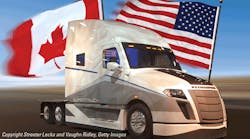ENVIRONMENT Canada is working closely with the US Environmental Protection Agency (EPA) to maintain a common Canada–United States approach to regulating greenhouse gas (GHG) emissions for post-2018 model year vehicles and engines.
This is a continuation of the close collaboration that led to the Heavy-Duty Vehicle and Engine Greenhouse Gas Emission Regulations published in Canada Gazette on March 13, 2013.
That rulemaking aligned Canada with US EPA standards and is estimated to result in a reduction of approximately 19.1 megatonnes (Mt) of CO2 in GHG emissions and net benefits of $US3.6 billion over the lifetime operation of vehicles produced in the 2014–2018 model year cohort. It is also estimated that the current regulations will achieve GHG emissions reduction of 3 Mt of CO2 equivalent per year by 2020 relative to a business-as-usual scenario, therefore contributing toward Canada’s commitment in the Copenhagen Accord.
The Department of the Environment intends to develop regulations under the Canadian Environmental Protection Act, 1999 (CEPA 1999) that are expected to contribute toward Canada’s commitment to reducing total GHG emissions by 17% from 2005 levels by 2020. The regulations apply to new on-road heavy-duty vehicles and engines of the 2014 and later model years.
Environment Canada has conducted aerodynamic testing and research with the US EPA, as well as emissions testing to support the development of common standards for heavy-duty vehicles—a collaboration that is taking place under the Canada–United States Air Quality Committee.
The idea is to build on the long history of regulatory alignment between the two countries on vehicle emissions pursuant to the Canada–United States Air Quality Agreement. Canada believes that common Canada–US standards will contribute to the preservation of the competitiveness of the Canadian industry, provide regulatory certainty to industry, and lower the compliance costs and administrative burden for Canadian companies, ultimately benefiting consumers.
The development of common North American standards provides a level playing field that leads North American manufacturers to produce more advanced vehicles at a lower compliance cost, according to the Canada Gazette.
“Although Environment Canada is working on this and has put out feelers to the industry, it is obvious that they will wait and see what EPA does before making any final decisions, in an effort to maintain as much harmonization of the regulations as possible,” said Don Moore, executive director of the Canadian Transportation Equipment Association. “Inclusion of trailers in this round is, of course, our biggest concern and we’re working closely with TTMA on this.”
Transportation is one of the largest sources of GHG emissions in Canada, according to the Gazette. In 2011, 24% of total Canadian GHG emissions came from transportation sources and 7% of total emissions came from heavy-duty vehicles alone. The government is committed to reduce greenhouse gas emissions by implementing a sector-by-sector approach, and has already published GHG regulations for Canada’s transportation and electricity sectors.
The current regulations apply to companies manufacturing and importing new on-road heavy-duty vehicles and engines of the 2014 and later model years for the purpose of sale in Canada.
They apply to the whole range of new on-road heavy-duty vehicles, from full-size pick-up trucks and vans to tractors and buses, as well as a wide variety of vocational vehicles such as freight, delivery, service, cement, and dump trucks. The current regulations also include provisions that establish compliance flexibilities that include a system for generating, banking, and trading CO2 emission credits, as well as flexibilities for advanced and innovative technologies to reduce GHG emissions.
Flexibilities for advanced technologies include incentives in the form of additional CO2 emission credits for hybrid vehicles, electric vehicles, and Rankine-cycle engines. Companies are also required to submit annual reports and maintain records relating to the GHG emission performance of their heavy-duty vehicles and fleets.
The Canadian Council of Ministers of the Environment (CCME) established a federal, provincial, and territorial working group on transportation emissions, and developed an action plan to reduce emissions from the transportation sector. Environment Canada will use this CCME working group as a means of communicating with the provincial and territorial governments on the development of heavy-duty vehicle GHG regulations for post-2018 model years.
The Minister of the Environment intends to initiate a process to amend the current regulations, which will include consultations with representatives of provincial and territorial governments, industry, non-governmental organizations, the public, and other key stakeholders. Input received during these consultations will be considered during the development of the proposed regulations that will be published in the Canada Gazette. A statutory consultation period will follow publication in the Canada Gazette.
As for the current regulations, the first report is due June 15 for the 2014 model year, and will document the environmental performance of vehicles and credit/ deficit calculations. Environment Canada will work with manufacturers and associations to coordinate reporting requirements. The content of the reports will be streamlined and limited for compliance verification and assessing the environmental performance of the regulations. Companies will maintain and submit evidence of conformity, to be provided upon request only.
Companies would be required to demonstrate compliance with emissions standards using prescribed emissions testing procedures or simulation modelling procedures, aligned with the US: computer simulation model (GEM) for vocational vehicles and prescribed test cycles on an engine dynamometer (engine only testing). EPA certificates are accepted to demonstrate compliance with the emissions standards.
Vehicles or engines must also comply with the On-Road Vehicle and Engine Emission Regulations: importation declaration; national emissions mark; maintenance and submission of records; application for exemptions; and notices of defect.
CO2 vocational vehicle emissions standards (g/ton-mile):
- Classes 2B, 3, 4, and 5: 388 g/ton-mile for model years 2014 to 2016, and 373 for 2017 and after.
- Classes 6 and 7: 234 for model years 2014 to 2016, and 225 for 2017 and after.
- Class 8: 226 for model years 2014 to 2016, and 222 for 2017 and after.
CO2 vocational engine emissions standards (g/BHP-hr):
- Light heavy-duty engines: 600 g/BHP-hr for model years 2014 to 2016, and 576 for 2017 and after.
- Medium heavy-duty engines: 600 for model years 2014 to 2016, and 576 for 2017 and after.
- Heavy heavy-duty engines: 567 for model years 2014 to 2016, and 555 for 2017 and after.
- Spark-ignition engine (gasoline): 627 for 2016 and after.
“The challenges have been around accounting for emissions numbers,” Moore said. “Since all heavy-duty chassis are manufactured outside of Canada, other than the PACCAR units from Quebec and some Hinos in Ontario, and all diesel engines are manufactured outside Canada, it makes the tracking of GHGs a little more challenging. It also means that vocational intermediate- and final-stage manufacturers may get pulled into the loop if they start messing with tires or exhaust after-treatment systems.
“There are a lot of complicated scenarios that come into play when vehicles move back and forth across the border during the manufacturing process. Identifying the importer of record and therefore the Canadian entity responsible for the vehicle and/or engine gets a little more difficult. Also, the risk of duplicate counting of GHG credits, etcetera, becomes a potential issue. The one saving grace is that a lot of the requirements are exempt for companies manufacturing fewer than 200 affected vehicles annually—most of the CTEA membership falls into this category—although there are still some basic reporting requirements.
“The most significant issue in Canada appears to be the fact that there are more complicated reporting rules because of the administrative differences. The requirements go beyond the chassis OEMs. Keeping this clear with our small and medium-sized vocational truck manufacturing members continues to be a challenge.
“Environment Canada has a pretty good breakdown of the different cross-border transactions, which may be helpful, and are in the process of developing a reporting structure that will hopefully keep things relatively simple.”
Here are some possible scenarios:
• Scenario 1.
A Canadian customer purchases truck through a dealer in Canada. The dealer acts as agent on behalf of a Canadian company to receive a customer order and arrange the final delivery of the vehicle to the customer. The Canadian company confirms the order (possibly financing) and authorizes truck assembly. The truck is assembled outside of Canada and shipped directly to the dealer. The vehicle title is transferred through the Canadian company via the dealer to the purchaser. The Canadian company is responsible for compliance and regulatory filings.
• Scenario 2.
A Canadian customer purchases a truck through a dealer in Canada. The Canadian company takes on responsibility for all aspects of the vehicle, which is assembled in Canada and modified by an affiliated chassis-builder/fitter. The “assembly” operation is under the control of the Canadian company. The Canadian company is responsible for compliance and regulatory filings. The Canadian company is a manufacturer and must be authorized to affix the National Emission Mark. ♦










